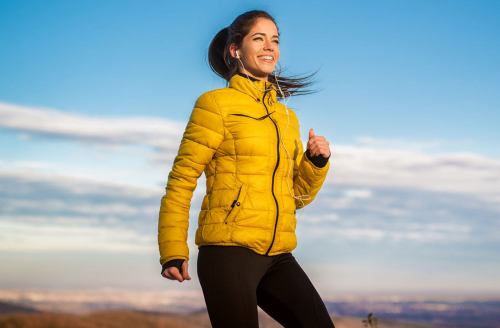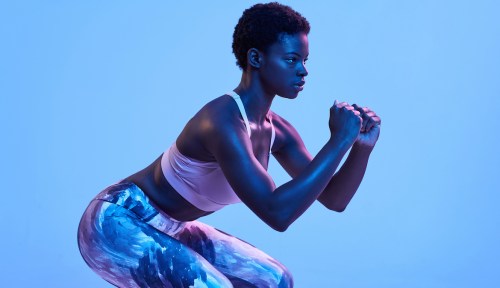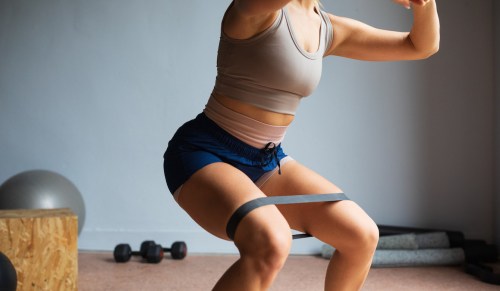If you could tune into your fellow gym patrons’ earbuds, you’d likely hear plenty of Cardi B, workout remixes of “thank u, next,” and likely, expert trainers coaching athletes. Yes, the age of audio-only fitness is upon us, fellow sweat-enthusiasts, and I’m here to report that it means good things for your beyond-busy schedule, your health, and your bank account.
Aaptiv—an audio fitness app that Fast Company reports currently caters to 200,000 members in 20 countries across the globe—has brought a wide-ranging number of workouts from treadmill running to boxing to ears everywhere. On average, 30,000 Aaptiv classes are taken each day. But while the company is certainly the titan of the space (they’re the sole app that’s solely focused on audio), other fitness giants have been flirting with the ears-only format, too. This summer, Peloton staked their claim in the on-demand scene with their digital iteration featuring both audio and visual streaming workouts. Then, ClassPass followed suit with their free app ClassPass Go featuring five- to 90-minute classes taught by expert trainers.
As for why the digital shift is occurring now? Nike master trainer Kirsty Godso suspects you can boil its popularity down to a magical combo of convenience and accountability. “People are spending more money than ever on their well-being from training to nutrition to recovery. This is definitely driving the dramatic increase in available options of streaming workouts.” On top of that, she adds that people are digging the fact that you can take these offerings wherever you may roam. And thus, there’s really no excuse for going a day without sweating.
Despite the anecdotal popularity of the format though (ask any audio exercise-lover about their habit and prepare for a long-winded love story), audio isn’t exactly booming yet in the grand-scheme of the $30 billion U.S. fitness market. A report from insights platform Alpha found that only seven percent of Americans surveyed subscribed to an in-home class. However, 54 percent of people who work out at least once a month are interested in buying an at-home fitness system, according to Fast Company. The number one thing holding people back? Space. A problem easily remedied by coupling audio fitness with a gym membership.
So at the moment, it does require a glance into a crystal ball to wager just how big audio could be, but a handful of industry pros are certainly willing to bet on it. Below, Godso and top contenders hash out why audio might just be the NBT in fitness.
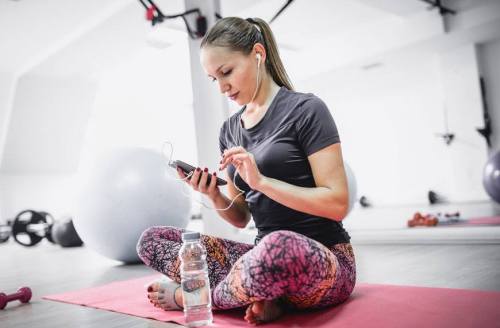
Audio offers at-home workouts that feel more natural and seamless to the body
“Being forced to be anchored to a five-inch screen, or your iPad, or even your TV just doesn’t make sense,” argues Ethan Agarwal, founder and CEO of Aaptiv. “If you’re doing downward dog or something and you’re watching a video, you’re craning your neck up to look at a screen so that you can see what the next move is. That just means that you’re doing the downward dog wrong.”
When it comes to cardio-based workouts, the folks at Peloton and ClassPass Go agree that strictly listening allows for fluid and free movement. “From a running coach’s point of view, regardless of whether you’re a track coach or a distance coach, you’re inevitably not with your runner side-by-side visually. So you have to fill their minds with the information that you want them to achieve in their run, be it splits to hit, be it distance, be it form,” Gentry says.
Of course, it takes a little extra cueing on the part of the trainers if they can’t demonstrate exactly what you should be doing. “The visual is a great way for us to reinforce the audio technique cues that are given with each exercise,” points out Godso, who has recorded video-inclusive streaming classes on the Nike Pro app. “It’s really important to be able to show both so you know exactly what you’re doing and reduce risk of injury. This is your body we’re talking about, it’s both expensive and important!”
That’s one of the reasons why Peloton decided to keep a few of the visuals on-app for users to refer back to when they’re unsure if their form might be lacking, explains Becs Gentry—one of the company’s tread instructor in New York. The minds behind ClassPass Go, on the other hand, aim for their video options to be something that athletes can eventually outgrow. “For a HIIT, or yoga, or pilates, we believe that you need to know the exercises that you have to do, and by having images or videos—what you’re instructed to do is better. And once you learn how to do it, just having a coach in your ear is a better experience than having to look at the screen,” says Javier Cardenete Morales, a senior software engineer at the company.
In short: Needing only your earbuds to do a workout does offer the most seamless experience. But first, you’ll need to lock-in the muscle memory of the moves so that an intense round of poorly-executed burpees doesn’t end in injury.
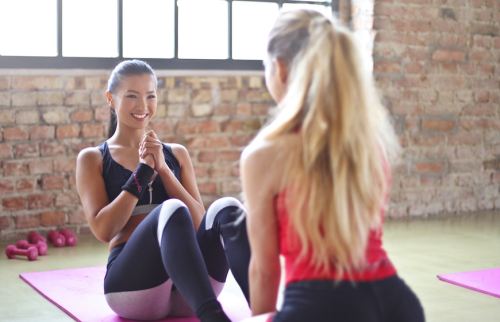
Audio is *extremely* scaleable—and therefore affordable
Depending on where you live, signing up for a single boutique class may set you back the price of a fancy dinner out. In fact, according to a 2018 study by My Protein (a sports and nutrition site), the average American spends $155 per month on their health and fitness. So why is it that Aaptiv can offer up pro coaching for only $15 a month? Peloton Digital, $19? ClassPass, $0?
Scaleability, plain and simple. “If your favorite studio opens up another location, then another one, and another one, they need to keep hiring more and more trainers, right? To fill those spots,” he explains. “In our case, we’ve had five trainers for years. We’ve grown significantly in that time, and these five trainers have been listened to by millions and millions of times because our content scales as a digital company.” So while you may feel like a coach is zeroing in on you in particular while guiding you through an abs-burning set of mount-climbers, the reality is that the trainer’s instruction can populate a seemingly infinite amount of eardrums right from a sound booth. There’s no need to pay rent on a studio, or someone to man check-in at the front desk, or to clean the space from top to bottom. Making the whole experience, well, cheap.
Notably though, Godso believes there’s definitely a trade-off when it comes to opting to work with trainers who can’t actually see your body. “Limitations definitely include no feedback from a trainer on your technique or monitoring of over-training,” she warns. “As more options become available, the quality of workouts and authenticity behind them can often seem questionable.” That’s why she recommends scheduling in at least some human-to-human face-time each week with someone who can find weaknesses in your form before they lead injuries.
In the future, audio workout platforms will get to know you
“The appeal of audio is that it’s applicable to all seven billion of us around the world. So that means we can create a very personal and specific experience for you because we’re able to customize the classes that you take and the audio experience that you have,” says Agarwal.
He hints that the Aaptiv of the future might recommend workouts the same way Netflix recommends your next binge-worthy series, or rather, by using what choices you’ve made in the past to inform how you’ll want to sweat in the future. So if you’ve taken two, 40-minute treadmill classes in the last week, you might just see a similar rec pop up on your home screen. “We can actually start both creating and recommending the thing that you will find interesting,” he tells me.
If you don’t know where to get started with the at-home fitness revolution, here are 13 of the best workout subscription services. Or if you want to go the extra-techy (and extra-pricey route), try The Mirror.
Sign Up for Our Daily Newsletter
Get all the latest in wellness, trends, food, fitness, beauty, and more delivered right to your inbox.
Got it, you've been added to our email list.
